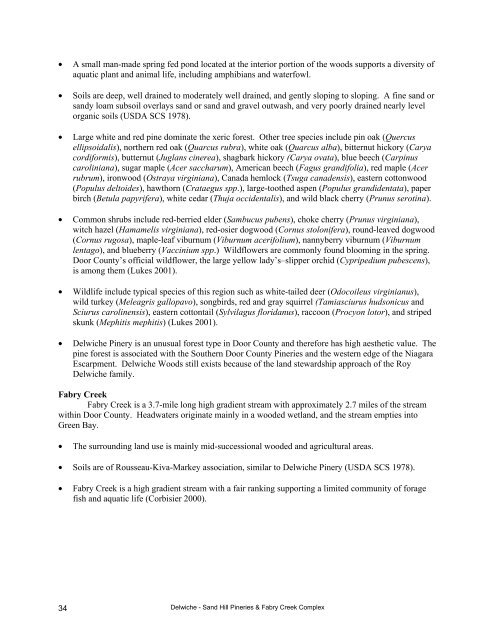Guide to Significant Wildlife Habitat - Door County Web Map
Guide to Significant Wildlife Habitat - Door County Web Map
Guide to Significant Wildlife Habitat - Door County Web Map
You also want an ePaper? Increase the reach of your titles
YUMPU automatically turns print PDFs into web optimized ePapers that Google loves.
• A small man-made spring fed pond located at the interior portion of the woods supports a diversity of<br />
aquatic plant and animal life, including amphibians and waterfowl.<br />
• Soils are deep, well drained <strong>to</strong> moderately well drained, and gently sloping <strong>to</strong> sloping. A fine sand or<br />
sandy loam subsoil overlays sand or sand and gravel outwash, and very poorly drained nearly level<br />
organic soils (USDA SCS 1978).<br />
• Large white and red pine dominate the xeric forest. Other tree species include pin oak (Quercus<br />
ellipsoidalis), northern red oak (Quarcus rubra), white oak (Quarcus alba), bitternut hickory (Carya<br />
cordiformis), butternut (Juglans cinerea), shagbark hickory (Carya ovata), blue beech (Carpinus<br />
caroliniana), sugar maple (Acer saccharum), American beech (Fagus grandifolia), red maple (Acer<br />
rubrum), ironwood (Ostraya virginiana), Canada hemlock (Tsuga canadensis), eastern cot<strong>to</strong>nwood<br />
(Populus del<strong>to</strong>ides), hawthorn (Crataegus spp.), large-<strong>to</strong>othed aspen (Populus grandidentata), paper<br />
birch (Betula papyrifera), white cedar (Thuja occidentalis), and wild black cherry (Prunus serotina).<br />
• Common shrubs include red-berried elder (Sambucus pubens), choke cherry (Prunus virginiana),<br />
witch hazel (Hamamelis virginiana), red-osier dogwood (Cornus s<strong>to</strong>lonifera), round-leaved dogwood<br />
(Cornus rugosa), maple-leaf viburnum (Viburnum acerifolium), nannyberry viburnum (Viburnum<br />
lentago), and blueberry (Vaccinium spp.) Wildflowers are commonly found blooming in the spring.<br />
<strong>Door</strong> <strong>County</strong>’s official wildflower, the large yellow lady’s–slipper orchid (Cypripedium pubescens),<br />
is among them (Lukes 2001).<br />
• <strong>Wildlife</strong> include typical species of this region such as white-tailed deer (Odocoileus virginianus),<br />
wild turkey (Meleagris gallopavo), songbirds, red and gray squirrel (Tamiasciurus hudsonicus and<br />
Sciurus carolinensis), eastern cot<strong>to</strong>ntail (Sylvilagus floridanus), raccoon (Procyon lo<strong>to</strong>r), and striped<br />
skunk (Mephitis mephitis) (Lukes 2001).<br />
• Delwiche Pinery is an unusual forest type in <strong>Door</strong> <strong>County</strong> and therefore has high aesthetic value. The<br />
pine forest is associated with the Southern <strong>Door</strong> <strong>County</strong> Pineries and the western edge of the Niagara<br />
Escarpment. Delwiche Woods still exists because of the land stewardship approach of the Roy<br />
Delwiche family.<br />
Fabry Creek<br />
Fabry Creek is a 3.7-mile long high gradient stream with approximately 2.7 miles of the stream<br />
within <strong>Door</strong> <strong>County</strong>. Headwaters originate mainly in a wooded wetland, and the stream empties in<strong>to</strong><br />
Green Bay.<br />
• The surrounding land use is mainly mid-successional wooded and agricultural areas.<br />
• Soils are of Rousseau-Kiva-Markey association, similar <strong>to</strong> Delwiche Pinery (USDA SCS 1978).<br />
• Fabry Creek is a high gradient stream with a fair ranking supporting a limited community of forage<br />
fish and aquatic life (Corbisier 2000).<br />
34<br />
Delwiche - Sand Hill Pineries & Fabry Creek Complex





![A Guide to the Control and Management of Invasive Phragmites [PDF]](https://img.yumpu.com/19126786/1/190x190/a-guide-to-the-control-and-management-of-invasive-phragmites-pdf.jpg?quality=85)






![Homeowner's Guide to Japanese Knotweed Control [PDF]](https://img.yumpu.com/19126766/1/190x245/homeowners-guide-to-japanese-knotweed-control-pdf.jpg?quality=85)




